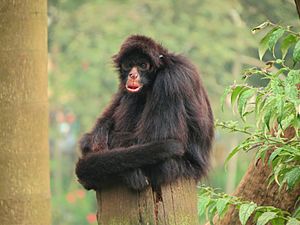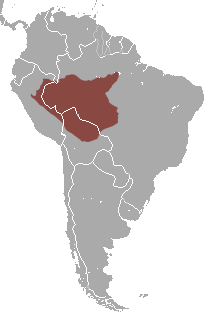Peruvian spider monkey facts for kids
Quick facts for kids Peruvian spider monkey |
|
|---|---|
 |
|
| Conservation status | |
| Scientific classification | |
| Genus: |
Ateles
|
| Species: |
chamek
|
 |
|
| Peruvian Spider Monkey range | |
The Peruvian spider monkey (Ateles chamek), also called the black-faced black spider monkey, is a type of spider monkey. These monkeys live in countries like Peru, Brazil, and Bolivia.
They are quite large for monkeys, growing up to 60 centimeters (about 2 feet) long. Their strong, gripping tails can be even longer, reaching up to 1 meter (about 3 feet). Unlike many monkeys, they have only a tiny, leftover thumb. This special hand helps them swing easily through the trees.
Peruvian spider monkeys live in groups of 20 to 30. However, you rarely see the whole group together. They often split into smaller groups. The size of these smaller groups changes depending on how much food is available. They love to eat juicy fruits. But if ripe fruit is hard to find, they will eat other things. They also eat small animals, insects, and leaves.
Female monkeys leave the main group to have their babies, usually in the fall. They stay in areas with lots of food during certain seasons. Male monkeys tend to travel farther than females. Young spider monkeys become independent around 10 months old. They can live for about 20 years.
Contents
What Does It Look Like?
The Peruvian spider monkey can weigh up to 9 kilograms (about 20 pounds). Its body can be up to 70 centimeters (about 28 inches) long. Its tail can be as long as 1 meter (about 39 inches).
It has four long fingers and almost no thumb. This is normal for spider monkeys but unusual for other monkeys. This helps them move easily through the trees. Like other spider monkeys, it has a special tail that can grab things. This tail helps it swing from branch to branch. Its amazing agility is like that of the gibbon from Asia. These monkeys can live for up to 20 years.
Where Do They Live?
This monkey lives in central-northern Bolivia, north-eastern Peru, and central-western Brazil. They were recently found in a new area in Brazil, near the Solimões River. They probably got there when the river changed its path.
Peruvian spider monkeys mostly live in lowland forests. They spend their time high up in the trees. But they can also live in other places, like dry, hilly areas. They move around to find food. They have also been seen living in Amazonian forests that flood during certain seasons.
They live in groups of 6 to 12 monkeys. Each group has a home area of about 20 square kilometers (about 8 square miles). The size of these groups changes with the seasons. This is because females leave the group for a few months to have their babies, usually in the fall. Peruvian spider monkeys share their home with other spider monkeys, woolly monkeys, and howler monkeys. They all compete for food and space.
What Do They Eat?
The Peruvian spider monkey eats many different things. It eats leaves, berries, flowers, and fruits. It also eats small animals like birds and frogs. Termites, honey, and grubs are also part of their diet.
They mostly eat fruit. But if fruit is scarce, they will eat more leaves. They also eat insects, baby birds, bird eggs, and frogs. In the Amazon, groups of these monkeys change where they look for food depending on when juicy fruits are available. Because they eat so many fruits, these monkeys help spread seeds for many trees in the Amazon. This helps new trees grow.
Life Cycle and Babies
Peruvian spider monkeys can have babies throughout the year. However, most babies are born at the start of the Autumn season. A mother monkey is pregnant for about 140 days.
The pregnant female leaves her group to have her baby. She returns to the group about 2 to 4 months later. A newborn spider monkey becomes independent around 10 months old.
Why Are They Endangered?
The Peruvian spider monkey, like other spider monkeys, is in danger. This is because people hunt them and their homes are being destroyed. It is currently listed as an Endangered species on the IUCN Red List of Threatened Species. This means their numbers have dropped a lot.
Experts believe that the number of these monkeys has gone down by at least 50% in the last 45 years. Researchers think that the monkeys might only live in 28% of their original home range. Also, only 32% of the areas where they live are legally protected. They also guess that 31–40% of their home will be lost by the year 2050.
One reason for this decline is that hunters target these monkeys. They are sold and eaten in the Amazonian bushmeat trade. Also, forests in the southern part of their home are being cleared for farms. In the southwestern Peruvian region of Madre de Dios, their home is being harmed by mining that is not allowed. In Peru, even in protected areas, people still illegally cut down trees and take wildlife.
Studies show that in places with a lot of hunting and farming, large monkeys like spider monkeys are often the first animals to disappear. Scientists at Reserva Ecologica Taricaya have started to help. They are reintroducing these monkeys along the lower Madre de Dios river. This area now has a safe place for them to live and protected forests.
Family and Relatives
The Peruvian spider monkey looks different from the red-faced spider monkey. They also have a different number of chromosomes. The red-faced spider monkey has 32 chromosomes, while the Peruvian has 34. They also have other small differences in their chromosomes. These two species have had babies together in zoos. Their babies could have some babies of their own, but not as easily.
Other related species include the Geoffroy's spider monkey (A. geoffroyi) from Central America. There is also the brown spider monkey (A. hybridus). The closest relative is the white-bellied spider monkey (A. belzebuth). All these spider monkeys have a gripping tail and a hand with almost no thumb. These are common features for all spider monkeys.
See also
 In Spanish: Maquisapa para niños
In Spanish: Maquisapa para niños


